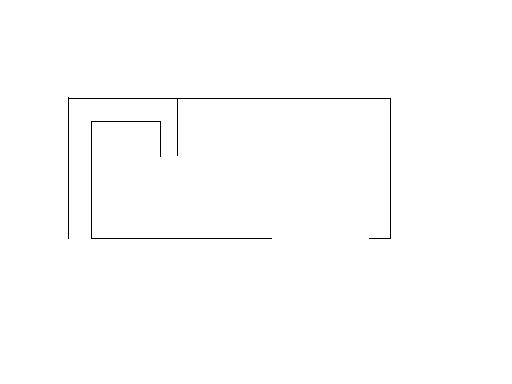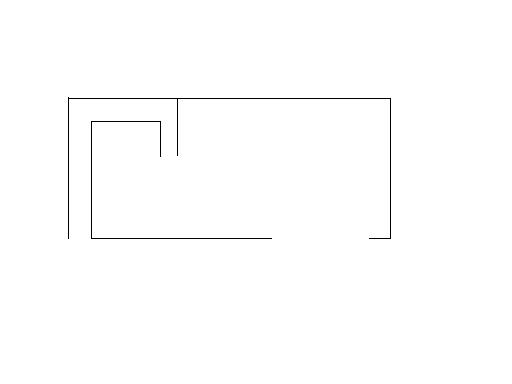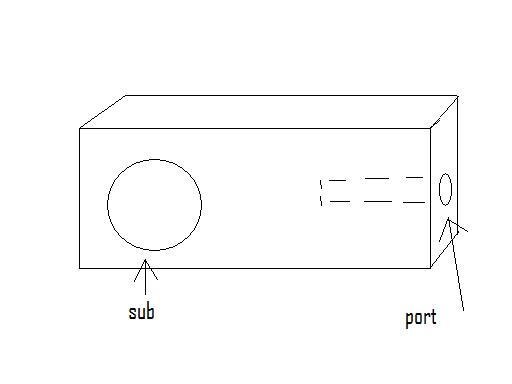port design
Printed From: the12volt.comForum Name: Car Audio
Forum Discription: Car Stereos, Amplifiers, Crossovers, Processors, Speakers, Subwoofers, etc.
URL: https://www.the12volt.com/installbay/forum_posts.asp?tid=105001
Printed Date: December 13, 2025 at 9:44 PM
Topic: port design
Posted By: johnny k-doe
Subject: port design
Date Posted: May 25, 2008 at 10:08 PM
I want to make a box with a port design such as in the example below.

Using WinISD to make sure the vent mach is appropriate, does the port size affect the sound to a noticeable degree? i.e. a narrow port versus a wider port? For example, a port 13" x 1" versus 13" x 2"? Directly related to this question, does the length of the port affect the sound to a noticeable degree? (Using the same example, 4.5" vs. 13.5"?) Perhaps a better way to put this question is: would there be a difference in the sound of a subwoofer using a port 13 x 1 x 4.5 versus 13 x 2 x 13.5 , keeping the size of the box constant?
On the same topic, how do bends in the vent affect the sound? (The picture example above versus the one below?)

I am sure there are places to find this information, I just can't seem to find them.
Thank you!
Replies:
Posted By: teenkertoy
Date Posted: May 25, 2008 at 11:38 PM
So yes, changing the port size will make a big impact on the sound, as will changing the length. Adding bends to the line will not dramatically change the sound, so long as the surface area and total length remain the same. Just remember the volume of the port does not count towards the box's volume for tuning purposes.
For what it's worth, I think your second drawing is a better design. It's certainly easier to build, and I think it will sound better too. If the extra tail end of that post inside the box extends into the box too far, I would worry the enclosure will start acting more like two smaller chambers than one large one. This is just a guess however.
More information can be found here and here:
https://www.the12volt.com/caraudio/boxcalcs.asp#por
https://www.diysubwoofers.org/prt/
-J
-------------
Malcom: "This is the captain. We have a...little problem with our engine sequence, so we may experience some slight turbulence and then...explode."
Jayne: "We're gonna explode? I don't wanna explode.
Posted By: johnny k-doe
Date Posted: May 26, 2008 at 12:54 AM
I'm torn between using a narrower port, making the port shorter (easier to build, and follows your suggestion, and makes a smaller box) and using a wider port (making it longer, harder to build, however a larger port seems to be recommended).
I just hate wasting time and money. Both of which I really don't have.
Posted By: teenkertoy
Date Posted: May 26, 2008 at 2:08 AM
The former is easier to build, takes less volume, and appears better overall. The latter will give you slower air velocity through the port, possibly reducing the wispy-breathing-sound air can make if pushed too fast through too small a port.
I'm not familiar with WinISD, but there should be a warning of some kind if you choose a port that is too small. Try, for fun, putting in really small dimensions like 1" x 1" square opening and see what happens.
I think you'll be fine with either port you have mentioned considering a 13"x1" slot has the same surface area as a 4" diameter tube. But if in doubt, go for the longer one with more surface area. You'll loose a little internal volume of the rest of the enclosure, but won't have any breathing problems and it'll sound just the same.
-Justin
-------------
Malcom: "This is the captain. We have a...little problem with our engine sequence, so we may experience some slight turbulence and then...explode."
Jayne: "We're gonna explode? I don't wanna explode.
Posted By: stevdart
Date Posted: May 26, 2008 at 6:00 AM
Of your two examples, the 13 * 2 * 13.5 is the only one that is acceptable. Use the ratio 8:1 to consider the limit of port length to width. A ratio of 1:1 (square) is better while an extremely narrow port is worse. This consideration takes tuning accuracy into account. The 13 * 1 opening is too narrow at a 13:1 ratio.
A second consideration regarding accuracy has to do with the port length. You want the port to be long enough to allow wiggle room for both ease of build and for inherent design inaccuracies. While it is sometimes possible to design a port at the desired tuning freq that is merely a hole cut into the MDF wall, it would be far too short for tuning accuracy. The 13.5" length allows for more of this wiggle room than does a 4.5" length and so is the better length to use. There is no ratio guide of box volume to port volume to follow; the design has to be a balance of tradeoffs of overall box size and reasonable port length.
The consideration for port noise has to do with the opening area of the port. Use the guide in the stickied threads for my comments on that.
-------------
Build the box so that it performs well in the worst case scenario and, in return, it will reward you at all times.
Posted By: teenkertoy
Date Posted: May 26, 2008 at 8:45 AM
-Justin
-------------
Malcom: "This is the captain. We have a...little problem with our engine sequence, so we may experience some slight turbulence and then...explode."
Jayne: "We're gonna explode? I don't wanna explode.
Posted By: DYohn
Date Posted: May 26, 2008 at 9:48 AM
-------------
Support the12volt.com
Posted By: johnny k-doe
Date Posted: May 26, 2008 at 7:20 PM
While I am on this subject, I would like to ask another question. All the info I find regarding port placement usually says to keep it its diameter length away from walls, other ports, & the sub, and also to have the port vent on the same side of the box that the subwoofer is mounted. How true are these, and why? It seems almost impossible to follow all these instructions (with straight ports - pvc) and have a box that will fit in a car.
I built a box that looks like the one below (not to scale).

This particular one (is actually two subs; basically two of these put together. Polk db12, if you want to know) is in a friends Ford Escort coup. The subs face upwards, and the vents fire into the cabin. Whenever it's not so loud that you can't think straight, it sounds good. Is there something wrong with this design?
Thank you!
Posted By: johnny k-doe
Date Posted: May 26, 2008 at 7:23 PM

Posted By: stevdart
Date Posted: May 26, 2008 at 8:50 PM
DYohn] wrote:
nother reason to use a shorter VS a longer port when possible is because it affects acoustic timing (specifically group delay.)
I didn't consider that as I'm not accustomed to seeing changes in group delay (with varying port lengths) using the two programs WinISD Pro and Unibox. A port tube can certainly turn into a "pitchfork", though, if it is extraordinarily long and especially if it's not stabilized along its length. If you are lucky enough to be able to get the port diameters "just right", there will be no bends and the port will fit easily one way through the box. Your main consideration, however, is port noise. The length will necessarily be what it has to be when you get the port diameter large enough to overcome noise.
johnny k-doe wrote:
All the info I find regarding port placement usually says to keep it its diameter length away from walls, other ports, & the sub, and also to have the port vent on the same side of the box that the subwoofer is mounted. How true are these, and why?The subs face upwards, and the vents fire into the cabin. Is there something wrong with this design?
I can't think of any acoustic problems that would be caused by allowing the port to be closer to the side of the box than its diameter. The fact is, most slot ports are built so that the port wall actually IS the sidewall of the box. But the space at the free end of the port is important! It is there where you want to make sure you leave that extra space. There is a small amount of space at both ends of a port that combine to function with the air in the port. This entire length of airspace is known as the "acoustical port" and is necessary for proper function and tuning. That means to leave plenty of space (the diameter of the port is the basic guideline, if the port is round) at the inside port opening, as well as to leave clearance at the port opening on the outside of the box.
Then what if the port is 12" X 1.5" slotted? Use the equivalent diameter of that opening if it were round, which would be about equal to a 5" round port...so you would want to leave 5" of free airspace at the open end of the port.
I built my main home speakers with the bass woofer ported to the rear. I think they sound just great, but then again I didn't design and test them any other way to do a comparison. It's a case of design tradeoffs: I didn't want the port on the front because I didn't want to see it. I think it would have messed up the whole Feng Shui of the design ;). But its a case there where the tuning is ultra low, into the sub range, and isn't critical to the sound of the woofer. It's mainly there because the parameters called for it. In the case of a car sub, however, the tuning is often an important part of the sub's impact and so it's more important to have the port firing alongside the driver, on the same baffle and in the same direction.
Know this, while you are designing the box: the driver and port act in harmony with one another in producing the sound. It makes the most sense that they should have the opportunity to send their soundwaves along basically the same path to your ears. Design as such if your box will permit it. But porting directly into the cabin while the driver is turned toward the trunk? No. At least, if the port has to be on a different baffle, face both the driver and port into the same airspace; if it's a trunk, they should both fire into the trunk.
-------------
Build the box so that it performs well in the worst case scenario and, in return, it will reward you at all times.
Posted By: johnny k-doe
Date Posted: May 27, 2008 at 1:14 PM
I am running into a bit of a problem designing MY next box, and I suppose it would be prudent to post the question here instead of making a new thread.
I have a pair of MA Audio MA120XL 12" subs. They are currently in a ported box, similar in design to the last picture posted; 3.5 cu. feet (total - about 3.25 w/o ports, sub, etc included), two 4" ports 13.75" long. Note - this is per sub, not for both subs. This box was actually recommended by MA Audio as "optimal". Optimal for what, I don't know.
I would like to build a new box, tuned lower in order to achieve frequencies I don't believe my subs reproduce well. In my opinion the box sounds great most of the time. However on certain songs with what seems like really low bass notes, the subs move back-and-forth quite wildly and sound not so good. I believe this is referred to as "unloading".
My real problem is I don't have the T/S parameters for the subwoofers; MA Audio does not have them (so they said), and I have been unable to find them on the internet. I have actually asked people that have posted on forums that have my same subs, but to no avail.
What would be the best method for designing a box for these subwoofers? Should I just stick with the size of the box and re-tune it?
Note - My vehicle is a Ford Explorer. Amp is HK401SX, running at 1 ohm.
Posted By: DYohn
Date Posted: May 27, 2008 at 1:45 PM
-------------
Support the12volt.com